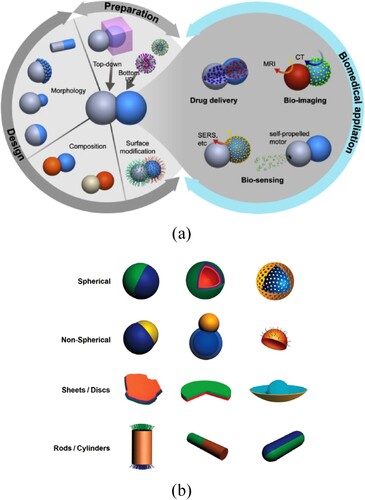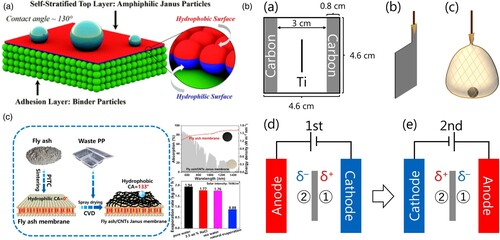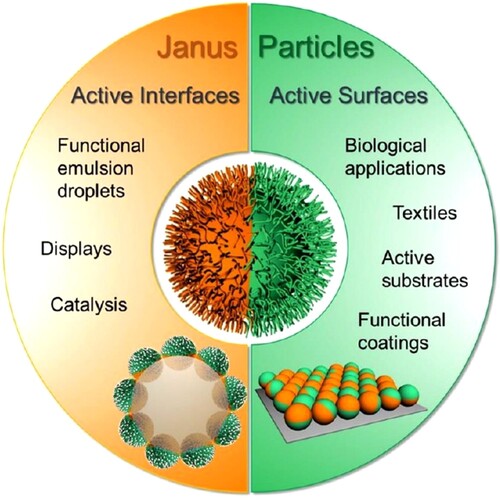ABSTRACT
As the development of nanostructured materials continues to blossom, there is increasing attention to functionalised particles. The so-called Janus particles are anisotropic regions having different physicochemical properties. The recent development of their synthesis in a pH field during suspension as bipolar particles between electrodes has opened the door to improved scalability due to the ease of entraining particles as a slurry in a flowing electrolyte stream. Potential application areas span catalysis of chemical synthesis, sustainable energy conversion and pharmaceutical and biomedical sectors of industry. In view of their versatility, the ability to undergo surface modification and opportunities for facile scale-up, Janus particles might be deployed as building blocks to fabricate functional surfaces having tailored chemical, structural and surface anisotropy. They could prove to be valuable feedstock in 3-D printing and surface finishing of fast prototype components and devices.
Introduction
According to ancient religion and mythology, Janus is the Roman god of beginnings, transitions, and endings: gates and doors. Janus is often shown with two faces, one looking to the future and the other to the past (). Interest in nanostructured materials has continued to mushroom in recent years, as has the development of techniques to tailor and surface functionalise particulate solids, including their surface finishing across a scale from laboratory bench research through to routine industrial production of materials and devices. Such interest has been fuelled by increasing needs for clean chemical synthesis, sustainable energy conversion, pharmaceutical and biomedical sectors of industry. The term ‘Janus beads’ was used in 1988, when Casagrande and co-workers described the behaviour of amphiphilic beads at oil−water interfaces. Janus particles were then suggested by Pierre-Gilles de Gennes in his 1991 Nobel Laureate speech to the scientific community (). The continued focus on 2-dimensional, layered materials creates the possibility of Janus materials which have two opposing sides or zones with distinct characteristics or exposed to a different local environment.
Figure 1. The Roman god of all beginnings, Janus is often shown facing two opposing directions. Photo by Andrey Kokorin on behance. https://www.behance.net/search/images.

Definition
Janus particles (JP) are anisotropic solid particles (often nanosized) which have zones with different physicochemical properties. Examples of such properties include:
surface wetting, zones being hydrophilic and hydrophobic, in the extreme case;
electrochemical activity, such as electrocatalysis of hydrogen and oxygen evolution;
biological activity, such as biocompatibility with tissue, blood or bone;
drug delivery, especially targeted and programmed examples;
tribological activity, such as wear resistance, low friction, self-cleaning, self-lubricating, corrosion protection or diagnostic ability.
Features
Over the last 20 years, JPs with various morphologies have been designed and prepared, ranging from simple spherical particles or regular geometrical shapes, such as a sphere, disk, cylinder or rod to more exotic shapes, including a dumbbell, snowman, microphone/matchstick, half-raspberry, hedgehog, mushroom and spider chrysanthemum (); core–shell, segmented and gradient composition, structure and morphology strategies are also possible. In some cases, surface features or morphology () are closely related to physicochemical properties. Different physicochemical zones on Janus particles can range from substantial regions through irregular patches to random doping or arrays of microdots. Early studies on Janus particles involved a wide range of particle sizes, from submicron to several microns; increasingly, nanosized particles are sought. It is important to realise that Janus particles can show a wide variety of asymmetry.
Figure 3. Anisotropic particle zones and examples of Janus particle shapes. From (a) H. Su, C.-A. Hurd Price, L. Jing, Q. Tian, J. Liu and K. Qian: Mats. Today Bio., 2019, 4, 100033 and (b) C. Zhang, F. Liang and Z. Yang: Design, synthesis, and application of anisotropic Janus particles’ Ch. 1 in ‘Soft, Hard, and Hybrid Janus Structures’, (eds. Z. Lin and B. Li) 1–30; 2017, World Scientific publishers. https://doi.org/10.1142/9781786343130_0001.

Synthesis
Bipolar electrolysis has been known and practised for a century, including industrial installations, as noted by, e.g., Mantell in 1950 and Walsh et al. in 1990–2020. In the case of flow reactors, both channel and bipolar trickle tower reactors are well known and have been extensively reviewed. In 2012, bipolar electrolysis to synthesise or modify Janus particles was revisited by Loget et al. to realise an important, general route to their synthesis. As shown in , electrically conductive particles can be suspended or flow as a slurry in the electrolyte between an anode and cathode. The particles experience a potential gradient which can electrochemically modify zones on the particle surface.
Potential uses
Potential application areas span catalysis of chemical synthesis, sustainable energy conversion, pharmaceutical and biomedical sectors of industry (). Concepts for the use of Janus particles include:
Self-driving electrochemical cells, e.g., a battery or corrosion cell
A driven, electrolytic cell used, e.g., for electrosynthesis.
A particle-based semiconductor device, such as a diode, transistor or chip.
A particle having a variable rotation speed or tilt, e.g., used as a molecular motor.
Self-propelling Janus particles, exploiting regions having different thermoelectric properties.
Magnetoelectric or optoelectronic response of Janus particles.
Differential wetting of faces or zones on Janus particles.
Charge storage devices, such as supercapacitors.
Coating surfaces with Janus particles
Janus particles can be suspended in a liquid electrolyte, sometimes with the aid of ultrasonics, then consolidated into a coating using well-developed surface finishing techniques including airless spraying, sol–gel dipping, electrodeposition of composites, anodising or electrophoretic deposition (). Examples of Janus particle-coating systems are suggested below:
Joint research at Binghamton University and Iowa State University mixed hydrophilic/hydrophobic Janus particles with commercial paints. The hydrophilic side of the resultant coating oriented to the surface and aided coating adhesion, while the hydrophobic side rendered the coating water-repellant. The particles diffused and arranged themselves into self-stratifying layers, showing a degree of self-assembly ((a)).
Titanium with two chemically distinct faces using two-step direct current (DC) bipolar anodisation. A Ti sheet was positioned vertically in the centre of an electrolytic cell as a bipolar electrode. The oxidation area on the bipolar electrode was identified as an interference colour due to the formation of a barrier-type oxide film in phosphoric acid. When different voltages were applied between the driving electrodes for the first and second steps, the front and back sides of the BPE showed distinct colours because of differences in film thickness ((b)).
Janus particles may be embedded in an ion exchange membrane for use as a composite bipolar electrode in a solid polymer electrolyte fuel cell or electrosynthesis cell.
Workers at Nanjing have considered polymer membranes containing Janus particles. When the hydrophilic part of the particle was close to the membrane or the particle had a larger area and higher hydrophilic coverage, the particle is more likely to be engulfed by the membrane. This provides a strategy to pass Janus particles through biomembranes for improved drug delivery.
Industrial solid waste coal fly ash and waste plastic polypropylene beads have been utilised as the raw materials to prepare carbon nanotubes (CNTs) in fly ash dual-layer Janus inorganic membranes, to achieve near-zero solid waste emission with fresh drinking water via solar membrane distillation. Chemical vapour deposition (CVD) was used to deposit the active material ((c)).
In view of their versatility, ability to undergo surface modification, opportunities for facile scale-up and self-orientation properties, Janus particles might be deployed as building blocks to fabricate functional surfaces having tailored chemical and structural heterogeneity. They could prove to be a valuable feedstock in 3-D printing and surface finishing of fast prototypes. The intense development of bipolar electrochemical reactors has not been fully appreciated in particle synthesis and their diverse reaction environments might enable the efficient synthesis and processing of Janus particles across a wide range of scales. Hybrid hydrocyclone-bipolar electrochemical cells would facilitate continuous removal of the Janus particles product from a slurry electrolyte.
Figure 7. (a) Self-stratification of amphiphilic Janus particles at paint coating surfaces. After Y. Li et al.: Materials Horizons, 2020, 7, 1923–2172. (b) Titanium with two chemically distinct faces using two-step direct current (DC) bipolar anodisation. A Ti sheet was positioned vertically in the centre of an electrolytic cell as a bipolar electrode (BPE). (a) Top-view of the open bipolar cell used for bipolar anodisation. (b) Vertically positioned Ti sheet. (c) Ti ball positioned in a mesh-like polyester bag. Schematic illustrations of the two-step anodisation: (d) first and (e) second anodising steps. After Y. Kokubo and H. Asho: Electrochemistry Communications, 2022, 142, 107376. (c) Carbon nanotubes in a Janus composite membrane prepared from fly ash and waste polypropylene beads for efficient solar membrane distillation. After Li et al.: J. Membrane Sci., 2023, 672, 121463.

The possible use of Janus particles in future coatings
The march of nanotechnology and the need to functionalise nanoparticles is continuing to create the need to realise surface active, functionalised particles. Janus particles are becoming better recognised and their opportunities in technology sectors are considered below.
Tribology, as a surface finish which can sense, or dynamically respond to, changing loads or dynamic environmental corrosion or wear conditions.
Electrocatalysis of specific reactions, such as hydrogen oxidation or oxygen reduction, in fuel cells for energy conversion.
Intelligent delivery of specific drugs, according to clinical needs in, e.g., blood sugar, insulin, viscosity modifiers or vitamin release.
A wide range of materials has been used to realise Janus particles, including polymers, ceramics, metals and diverse composites.
The techniques used to synthesise Janus particles continue to diversify and become more suited to scale-up.
As miniaturisation continues, one of the intriguing possibilities offered by Janus particles is the realisation of particle-based devices, based on electrochemical cells, sensors, catalysts, semiconductors or microfluidics. Particle-based chips and ‘lab-on-chip’ devices should be possible.
Such devices could deploy the benefits of easy transport, handling, processing and characterisation of well-defined solid particles together with properties such as self-stratification of resultant coatings.
Continued ambition during R & D of nanoparticles includes the search for chameleon particles, which have different properties (hence changing ‘personalities’) depending on time and exposure to stimulants in photolytic, magnetic, electrical or electrochemical fields.
Advances in nanoparticle processing, including their surface engineering and finishing, will necessitate practitioners, both in the laboratory and in industry, becoming familiar with the tools and techniques involved in their processing, including microfluidics for electrolyte droplet formation and flow, electrohydrodynamics of charged particle transport in an electric field and solid particle analysis in liquid slurries, sols and suspensions.
A new generation of thin materials, including textiles can be produced and surface functionalised using electrohydrodynamic techniques such as electrospinning and electrospraying. The micro- or nano-scale particles functionalising the surface can include polymers, ceramics, metals, metal compounds, composites and many biochemicals, including bactericides in wound dressings.
Further Reading
- K. Andrias: Supreme Court Rev., 2018, 2019, 21–58.
- J. Zhang, B. A. Grzybowski and S. Granick: Langmuir, 2017, 33, 6964–6977.
- G. Loget, J. Roche, E. Gianessi, L. Bouffier and A. Kuhn: J. Am. Chem. Soc., 2012, 134, 20033–20036.
- G. Loget, J. Roche and A. Kuhn: Adv. Mater., 2017, 3, 6964–6977.
- A. Walther and A. H. E. Muller: Chem. Rev., 2013, 13, 5194–5261.
- F. C. Walsh, C. Ponce de Leon, D. V. Bavykin, C. T. J. Low, S. C. Wang and C. Larson: Trans. IMF, 2015, 93, 209–224.
- F. C. Walsh, C. Ponce de Leon, D. V. Bavykin, C. T. J. Low, S. C. Wang and C. Larson: Trans. IMF, 2015, 93, 241–247.
- H. Su, C.-A. H. Price, L. Jing, Q. Tian, J. Liu and K. Qian: Mater. Today Bio., 2019, 4, 100033.
- A. Kirillova, C. Marschelke and A. Synytska: ACS Appl. Mater. Interfaces, 2019, 11, 9643–9671.
- C.L. Mantell: ‘Industrial Electrochemistry’, 3rd edn, New York, McGraw-Hill, 1950.
- D. Pletcher and F.C. Walsh: ‘Industrial Electrochemistry’, 2nd edn, London, Springer, 1992.
- F. C. Walsh and C. Ponce de León: Electrochim. Acta, 2018, 280, 121–148.
- S. C. Perry, C. Ponce de León and F. C. Walsh: J. Electrochem. Soc., 2020, 167, 155525.
- L. F. Arenas, C. Ponce de León and F. C. Walsh: J. Electrochem. Soc., 2020, 167, 023504.
- F. C. Walsh, L. F. Arenas and C. Ponce de León: J. Electrochem. Soc., 2021, 168, 023503.
- C. Marschelke, A. Fery and A. Synytska: Colloid Polym. Sci., 2020, 298, 841–865.
- S. Jiang, A. Van Dyk, A. Maurice, J. Bohling, D. Fasano and S. Brownell: Chem. Soc. Rev., 2017, 46, 3792–3807.




